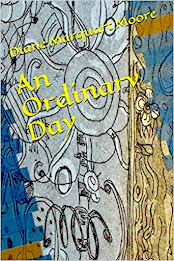“Prowling his own quiet backyard or asleep by the fire, he is still only a whisker
away from the wilds.” – Jean Burden -
This world is a jungle where the ginger tabby roams free. He crosses my patio and pauses before St. Francis: an icon of celibacy in stone. Tabby looks into the expressionless face, searching for clues about keeping himself from roving around all night, spraying car tires, eating poisoned food, getting chased by wild dogs…he may as well be a black cat without any future. I see questions forming in his sly eyes: What is the secret in the stone heart that keeps St. Francis home at night, at peace with desire? Why do his arms embrace birds rather than chase them? A sparrow lights on the tonsured head, questions rising in the muggy air. Enough. The tabby lunges, toppling St. Francis, scattering the shards of piety.
 |
| Yellow tomcat and St. Francis |
Tabby's a stately creature that I seldom see crouched in attack position or running after others. He just walks sedately past my window, always in command of the territory under my carport, which he has marked several times. I envy him his composure and lack of fear. Vets report that he's exposed to AIDS the same as careless humans are, and because of his dalliances, he could become a victim. Perhaps that’s why he seemed to be imploring St. Francis to tell him about celibacy. But, then, he did shatter the stony saint.
Three miniature dogs down the street yip at Tabby when he passes, but his disdain of the canines matches that of his composure. At night, he jumps on my rooftop and centers his body above my bedroom, thudding heavily to let me know that he regards my habitat as his territory. I’m startled into consciousness and run to the window to see if a branch has fallen or someone has thrown a shoe at him. I hear nothing but the hum of the refrigerator and see only the dark street. It’s 2 a.m., and he’s dancing on my rooftop. What’s up there? He dares me to come out and search for him, but I go back to bed, wishing he’d find a Mehitabel and create a family of his own, but he’d probably desert her just as the reincarnated cat poet, Francois Villon, did, and she’d drop her kittens in a rain barrel…
I receive an e-mail from Sewanee, Tennessee where I reside in the Spring and Summer: “Residents tell me tonight that they have confirmed there are three yellow cats in the area. Two have homes. The third is an unaltered male with claws intact. Very friendly, appears healthy and clearly wants his home. Will enter houses and doesn’t seem very afraid of dogs…” Could Tabby have gone East looking for my second home?



























